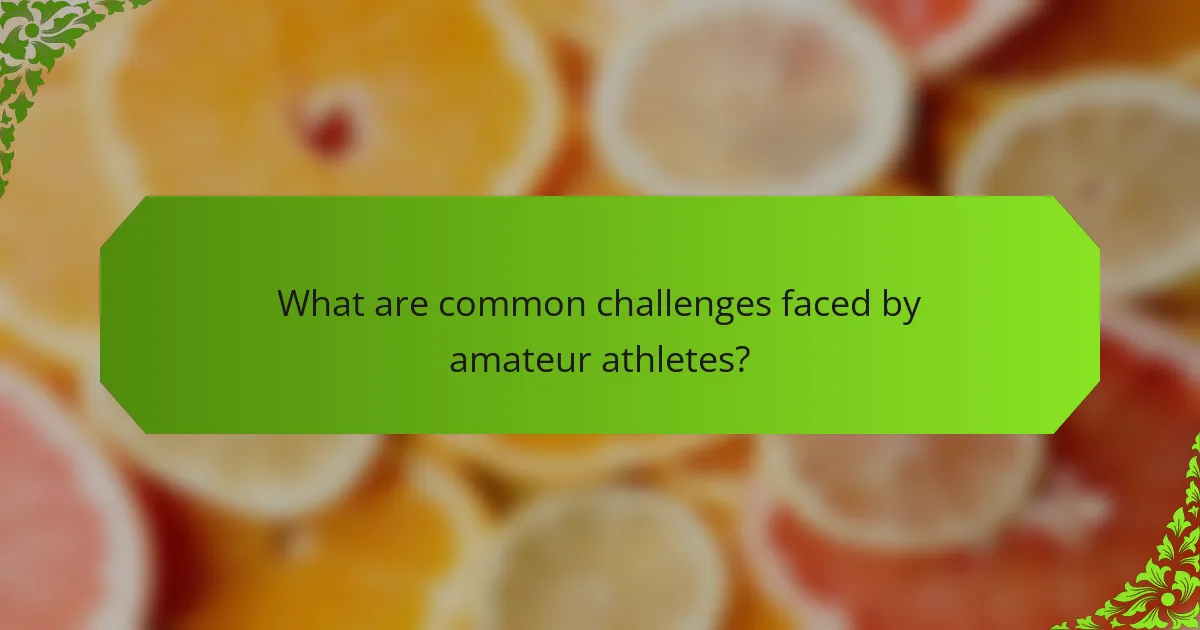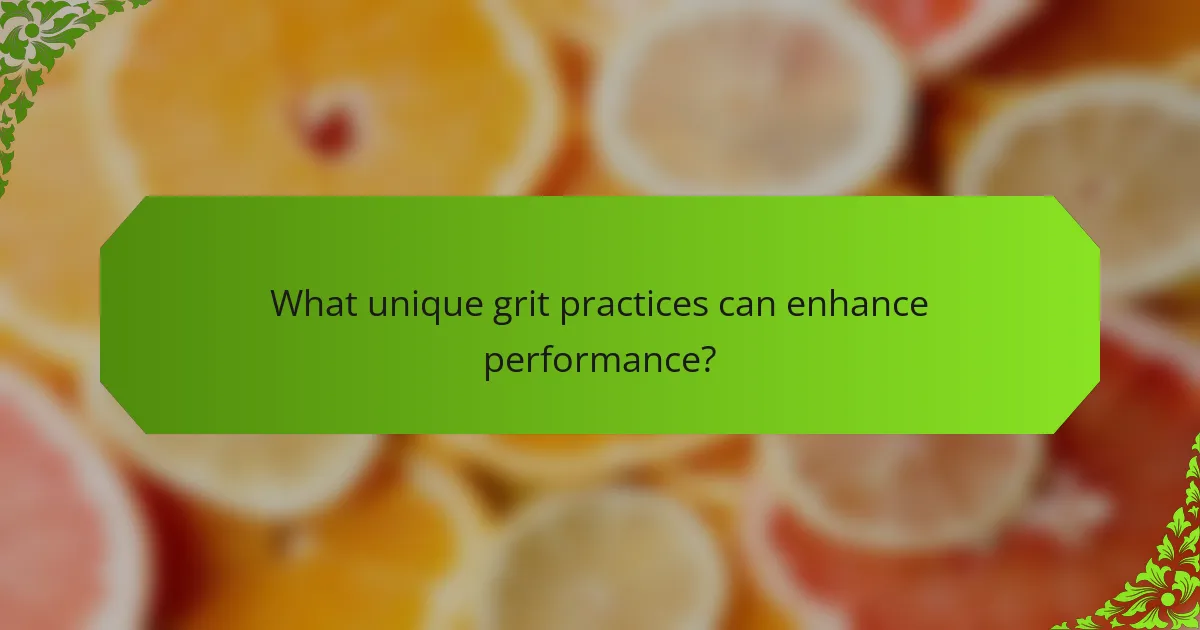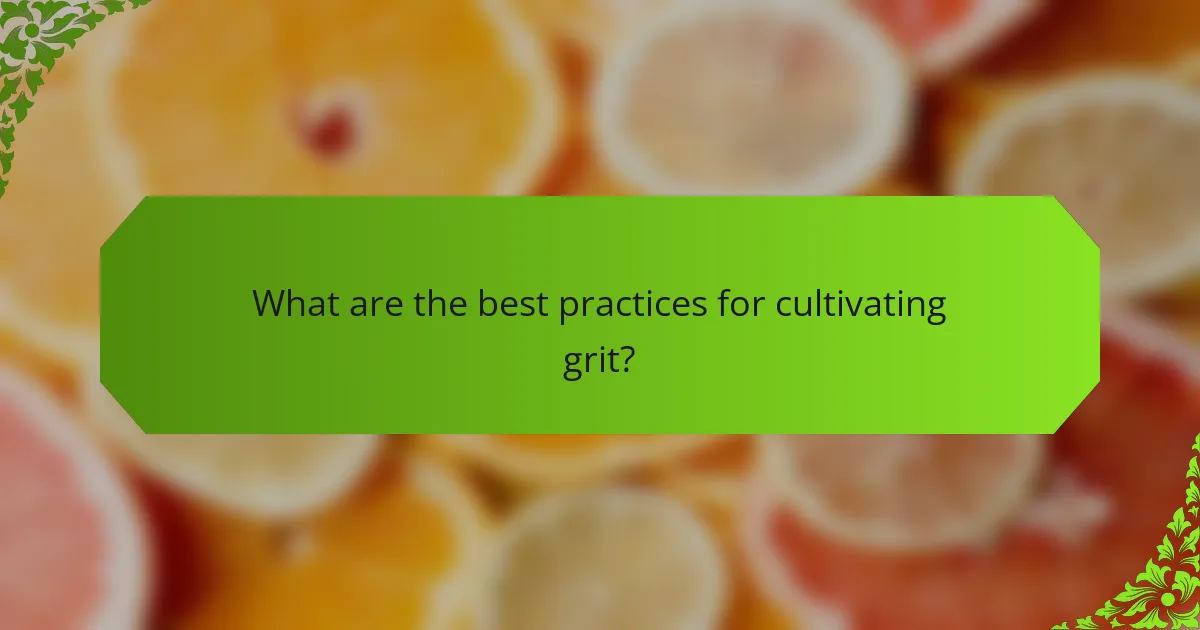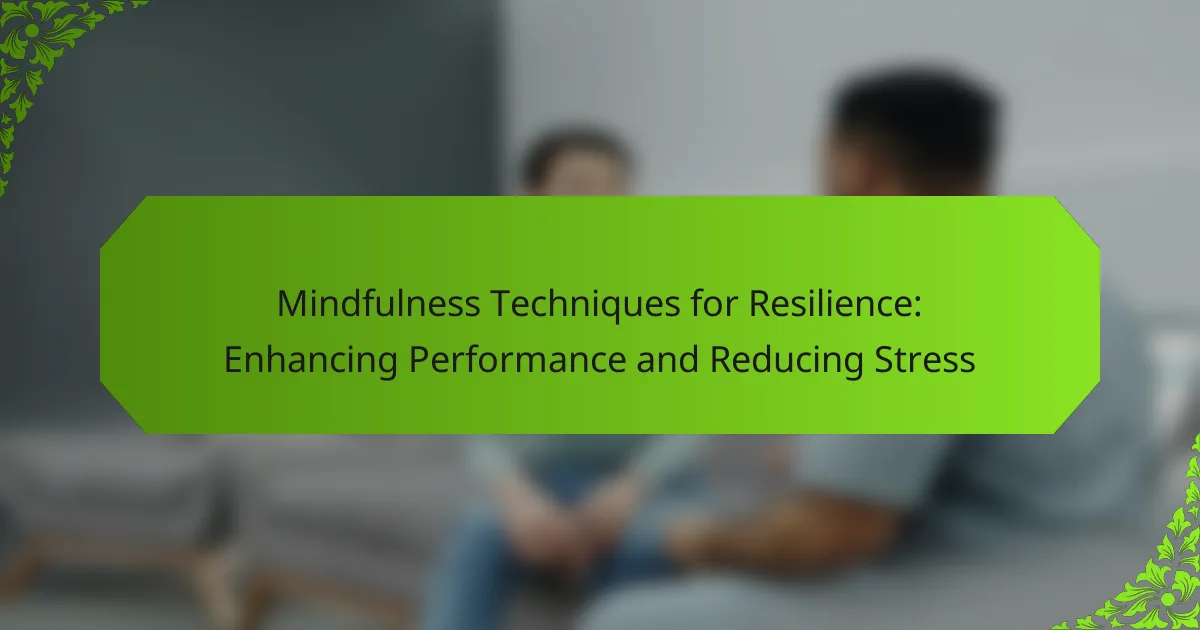Amateur athletes often struggle with challenges like time management, injuries, and mental fatigue. Developing grit through structured practices enhances perseverance and adaptability. Key techniques include goal setting, visualization, and resilience training. Cultural influences shape these practices, impacting motivation and approaches to overcoming setbacks.

What are the key characteristics of grit in amateur athletes?
Grit in amateur athletes involves perseverance, resilience, and passion for long-term goals. Key characteristics include a strong work ethic, the ability to overcome setbacks, and sustained commitment to training. These attributes help athletes maintain focus during challenges and foster continuous improvement. Research shows that grit correlates positively with athletic performance, indicating its importance in achieving success.
How does grit influence athletic performance?
Grit significantly enhances athletic performance by fostering resilience and determination. Athletes with high grit persist through adversity, leading to improved training outcomes and competition results. Research indicates that grit is linked to better goal-setting and achievement in sports. For example, a study found that gritty athletes are more likely to stick with rigorous training regimens, ultimately resulting in higher levels of performance. This unique attribute of grit differentiates successful athletes from their peers, as they embrace challenges rather than shy away from them.
What role does perseverance play in developing grit?
Perseverance is crucial for developing grit, as it fosters resilience in the face of challenges. Amateur athletes who consistently push through obstacles enhance their ability to remain committed to long-term goals. This persistence builds a strong foundation for grit, characterized by sustained effort and determination. Research shows that individuals who practice perseverance are more likely to achieve success in their athletic endeavors. Thus, cultivating perseverance directly contributes to the development of grit in sports.
How can amateur athletes measure their grit levels?
Amateur athletes can measure their grit levels through self-assessment, goal-setting, and reflective journaling. Self-assessment involves rating personal perseverance in challenging situations. Goal-setting focuses on creating short- and long-term objectives that push limits. Reflective journaling allows athletes to analyze experiences, identifying moments of resilience and areas for improvement. These practices cultivate persistence, a key attribute of grit, ultimately enhancing performance.

What are common challenges faced by amateur athletes?
Amateur athletes commonly face challenges such as time management, injuries, mental fatigue, and lack of resources. These hurdles can hinder their performance and development.
Time management is crucial as athletes juggle training, work, and personal commitments. Injuries often disrupt training schedules, leading to frustration and setbacks. Mental fatigue can diminish motivation and focus, impacting performance levels. Limited access to quality coaching and facilities can restrict skill development and growth opportunities.
Developing grit through structured practices helps athletes overcome these challenges. Techniques such as goal setting, visualization, and resilience training foster persistence and adaptability.
How do setbacks impact an athlete’s mindset?
Setbacks can significantly enhance an athlete’s mindset by fostering resilience and determination. Embracing challenges helps athletes develop grit, which is essential for long-term success. Research indicates that athletes who view setbacks as learning opportunities are more likely to persist and improve their performance. This perspective shift transforms obstacles into stepping stones, reinforcing the unique attribute of adaptability in their training. As a result, setbacks become valuable experiences that shape an athlete’s mental toughness and commitment to their goals.
What are effective strategies for overcoming injuries?
Effective strategies for overcoming injuries include building mental resilience, focusing on rehabilitation, and maintaining a positive mindset. Grit practices, such as goal setting and visualization, enhance persistence during recovery. Consistent effort in physical therapy and cross-training aids in regaining strength. Embracing a supportive community fosters motivation and accountability, essential for long-term success.
How can time management improve persistence in training?
Effective time management enhances persistence in training by allowing athletes to allocate specific periods for practice and recovery. This structure fosters consistency, a key component of grit. Athletes can track progress, set achievable goals, and maintain motivation. By organizing their schedules, they reduce stress and improve focus, which reinforces their commitment to training. As a result, time management becomes a critical tool for developing resilience in the face of challenges.

What unique grit practices can enhance performance?
Practices such as goal setting, visualization, and resilience training can significantly enhance performance for amateur athletes. Goal setting helps athletes focus on specific targets, improving motivation and persistence. Visualization techniques enable athletes to mentally rehearse their performance, boosting confidence and reducing anxiety. Resilience training involves developing coping strategies for setbacks, fostering a growth mindset that enhances overall perseverance.
How can visualization techniques foster grit?
Visualization techniques can significantly enhance grit by helping amateur athletes mentally rehearse challenges and visualize success. These techniques foster persistence through goal setting and problem-solving imagery. By creating vivid mental scenarios, athletes build resilience and enhance motivation, making them more likely to overcome obstacles. Visualization also helps in managing anxiety, allowing athletes to approach challenges with confidence. Regular practice of these techniques can lead to a unique ability to maintain focus and determination during tough situations, ultimately developing a stronger mindset.
What role do goal-setting practices play in persistence?
Goal-setting practices enhance persistence by providing clear objectives and motivation. They help amateur athletes maintain focus during challenges, fostering grit. Specific, measurable goals create a roadmap for progress, while regular assessment of achievements reinforces commitment. This structured approach cultivates resilience, enabling athletes to push through setbacks and stay dedicated to their long-term aspirations.
How can community support bolster an athlete’s grit?
Community support significantly enhances an athlete’s grit by providing encouragement and resources. Support networks, including family, friends, and coaches, foster resilience through shared experiences and motivation. For instance, athletes who engage with supportive communities often report increased persistence in overcoming obstacles. This unique attribute of collective encouragement helps athletes develop a stronger mindset, essential for enduring challenges. As a result, community support acts as a catalyst for personal growth and sustained athletic performance.

What rare attributes contribute to exceptional grit?
Exceptional grit in amateur athletes is often influenced by rare attributes such as intrinsic motivation, adaptability to failure, and a strong sense of purpose. These traits empower athletes to persist through challenges and setbacks. Intrinsic motivation drives them to pursue goals for personal satisfaction rather than external rewards. Adaptability to failure allows them to learn from mistakes and adjust strategies effectively. A strong sense of purpose provides clarity and direction, reinforcing commitment to long-term objectives. These rare attributes collectively enhance resilience and the ability to overcome obstacles in athletic pursuits.
How does a growth mindset uniquely affect grit?
A growth mindset enhances grit by fostering resilience and a willingness to learn from failures. Athletes with a growth mindset view challenges as opportunities for growth, which strengthens their persistence. This unique perspective enables them to overcome obstacles more effectively, ultimately leading to greater success in their athletic pursuits. Research shows that individuals with a growth mindset are more likely to engage in effortful practice, which is essential for developing grit.
What uncommon experiences shape an athlete’s resilience?
Uncommon experiences that shape an athlete’s resilience include overcoming injuries, facing intense competition, and navigating personal challenges. These situations foster grit and perseverance, essential traits for amateur athletes. For instance, athletes who recover from significant injuries often develop a unique mental toughness, learning to adapt and push through setbacks. Additionally, competing against higher-level opponents provides rare opportunities for growth, as athletes learn to handle pressure and improve their skills. Personal challenges, such as balancing sports with academics or family responsibilities, also contribute to resilience, teaching athletes valuable time management and prioritization skills.

How can cultural differences influence grit practices?
Cultural differences significantly shape grit practices among amateur athletes. These variations impact motivation, resilience, and approaches to challenges.
For instance, collectivist cultures may emphasize teamwork and community support, fostering persistence through shared goals. In contrast, individualistic cultures often promote personal achievement, encouraging self-reliance and individual grit.
Additionally, cultural narratives around failure influence how athletes perceive setbacks. Cultures that view failure as a learning opportunity may encourage a more resilient mindset. Conversely, those that stigmatize failure could hinder persistence.
Understanding these cultural influences can help coaches and athletes tailor grit practices to enhance performance and overcome challenges effectively.
What region-specific challenges do amateur athletes encounter?
Amateur athletes face region-specific challenges that impact their performance and development. Geographic location influences access to training facilities, coaching quality, and competition levels.
In rural areas, limited resources may hinder skill development, while urban settings might present overcrowded facilities. Weather conditions can also affect training consistency, especially in regions with extreme climates.
Cultural factors play a role as well; some regions may prioritize certain sports, impacting youth participation. Additionally, socioeconomic disparities can limit access to necessary equipment and training opportunities, creating barriers for aspiring athletes.
These challenges require grit practices to foster resilience and adaptability in amateur athletes.
How can regional sports communities enhance grit development?
Regional sports communities can significantly enhance grit development by fostering a supportive environment and promoting resilience. These communities provide opportunities for athletes to face challenges collectively, encouraging persistence through shared experiences. Engaging in team activities cultivates accountability, which reinforces commitment to long-term goals. Research shows that social support within sports settings correlates with increased mental toughness, critical for developing grit. Additionally, mentorship programs within these communities can offer guidance, helping athletes navigate obstacles effectively, further solidifying their persistence and determination.

What are the best practices for cultivating grit?
To cultivate grit, amateur athletes should consistently set challenging goals, embrace discomfort, and maintain a growth mindset. Regularly reflecting on progress and learning from setbacks enhances persistence. Building a supportive community fosters resilience. Lastly, celebrating small victories reinforces motivation and commitment.
How can athletes develop a daily grit routine?
Athletes can develop a daily grit routine by incorporating consistent practices that build resilience. Start with setting specific, achievable goals each day to foster a sense of purpose. Engage in reflective journaling to identify challenges faced and lessons learned. Implement a structured training schedule that includes both physical and mental exercises, emphasizing persistence. Finally, practice visualization techniques to mentally prepare for obstacles, reinforcing a growth mindset.
What common mistakes should athletes avoid in their grit journey?
Athletes should avoid common mistakes that hinder their grit journey, such as setting unrealistic goals, neglecting recovery, and lacking consistency in training. These pitfalls can undermine persistence and resilience.
Unrealistic goals can lead to frustration and burnout. Proper recovery is essential for physical and mental resilience. Consistency in practice builds habits that foster grit, while skipping it can stall progress.
Additionally, ignoring feedback from coaches or peers can result in repeated mistakes. Athletes should embrace constructive criticism to improve their skills and mindset. Lastly, comparing oneself to others can diminish self-confidence; focusing on personal progress is crucial for developing a strong grit foundation.
What expert insights can help in building persistence?
To build persistence, amateur athletes should adopt grit practices that enhance their mental resilience. Setting specific, achievable goals fosters commitment and motivation. Regular self-reflection helps identify strengths and areas for improvement, reinforcing a growth mindset. Seeking support from coaches and peers creates a supportive environment, which is crucial for overcoming challenges. Lastly, maintaining a balanced routine that includes rest and recovery ensures sustained performance and mental endurance.

